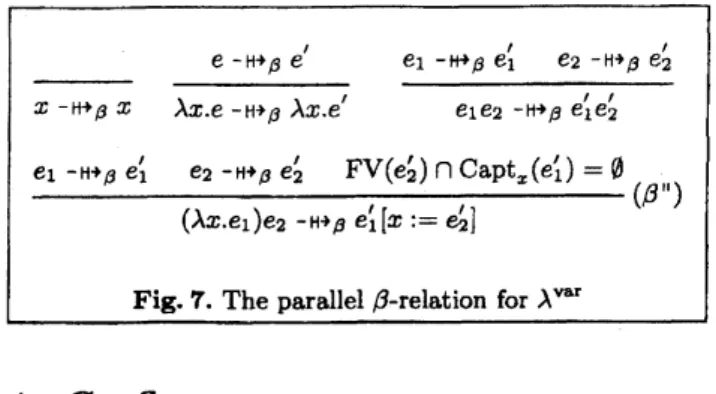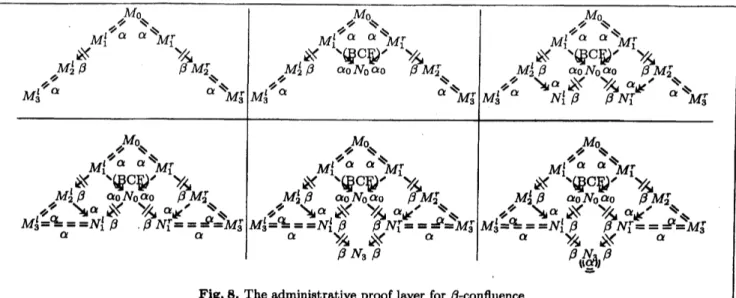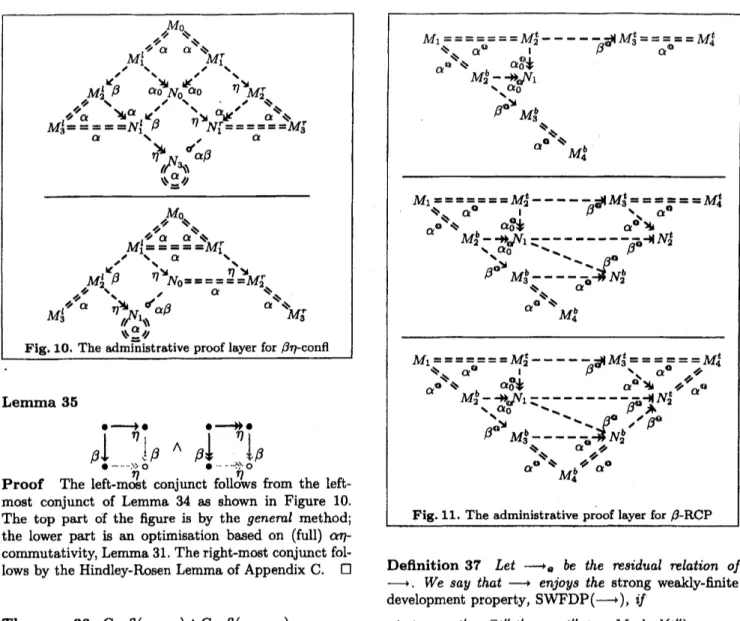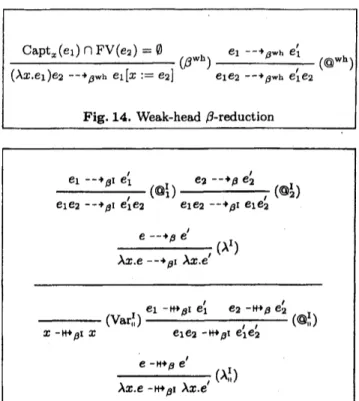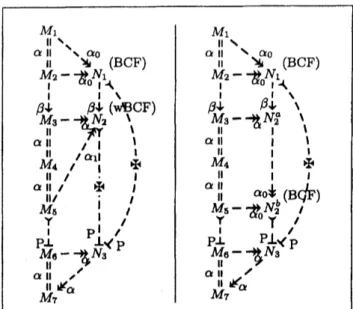Structural
Induction and the
A-Calculus
Rene’ Vestergaard*
School of InformationScience
JapanAdvanced Institute ofScienceandTechnology
Abstract. We consider formal
provabil-ity with structural induction and related
proof principles in the $\lambda$-calculus presented
with first-0rder abstract syntax over
one-sorted variable names. As well as
sum-marising and elaborating on earlier,
for-mally verified proofs (in $\mathrm{I}\mathrm{s}\mathrm{a}\mathrm{b}\mathrm{e}\mathrm{l}\mathrm{l}\mathrm{e}/\mathrm{H}\mathrm{O}\mathrm{L}$) of the relative renaming-freeness of $\beta-$ residual theory and $\beta$-confluence, we also present proofs of$\eta$-confluence,$\beta\eta-$-confluence,
the strong weakly-finite $\beta$-development(aka
residual-completion) property, residual $\beta-$
confluence $\eta-\mathrm{o}\mathrm{v}\mathrm{e}\mathrm{r}-\beta$-postponement, and no
tably$\beta$-standardisation.Inthelatter case,the
known proofs fail in instructiveways.
Interest-ingly, our uniform proof methodology, which
has relevance beyond the A-calculus, proof
erlycontains pen-and-paper proof practices in
aprecise sense. The proofmethodology also
makes precisewhat isthe fullalgebraic proof
burden of the considered results, which we, moreover, appear to be the first to resolve.
1Introduction
The use of structural induction and related proof
prin-ciplesfor simple syntax (i.e.,first-0rderabstract syntax
over one-sorted variable names) is along-standing and
widely-usedpracticein the programming-language
the-orycommunity.Unfortunately, atafirst, closer inspec-tion it seems that the practice is not formally
justifi-able because of aneed to avoid undue varijustifi-able capture when performing substitution, thus breaking the
syntac-tic equality underlying structural induction, etc.. Even
more
worrying is the fact that, in spite of substantialefforts in themechanised theorem-proving community,
no
formal proof developments (priortowhatwe
reportonhere) have been able to
overcome
the problems thatare
encountered with substitution andgoontosuccess-fully employ the proof principles in question. Indeed,
and starting with de Bruijn [6], it has becomeanactive
research
area
to define, formalise, and automatealter-native syntactic frameworks that,onthe
one
hand,pre-serve
asmuch ofthe inherentnaturalityof simplesyntaxas possible. At the same time, they are customised to
provide suitable induction and recursion principles for
any considered language [6-10,12, 17,21]. However, by
changing the underlyingsyntacticframework, the
alge-braic meaningof,$\mathrm{e}.\mathrm{g}.$,adiamond property also changes,
which
means
that, e.g., confluence as provedandasdefinedno longercoincide, cf.Lemma 18 and [25].
In the recognition that the above is both
unfortu-nateasfarastheformal status of the existing informal
literature isconcerned andunsatisfactoryfrom
amath-ematical Perspective, we pursue the naive approach in
this article (while incorporating the relevant aspects of
$[24, 25])$
.
In particular, we show that it is, indeed, possible to base formal proofs on first-0rder abstract
syn-tax over one-sorted variable
names
and hope tocon-vince the reader that, while the technical gap between
pen-and-paper and formal proofs is rather large, the
conceptual gap is somewhat smaller. Furthermore, we
hope that the comprehensive range of applications of
the proof methodology that wepresent here will estab
lish its widerrelevance.
1.1 Syntax ofthe A-Calculus
The A-calculus is intended to capture the concept of
afunction.
It does so, first ofall, by providing syntaxthat can be used to express function application and
definition:
$e::=x$ $|e_{1}e_{2}|$ Xx.$\mathrm{e}$
The above, informal syntax says that aA-term, $e$,
is defined inductively
as
either avariable name,as an
application of
one
term to another,or
as a$\lambda-$,or
func-tional, abstraction of avariable
name
over aterm. Thevariable names, $x$,
are
typically taken to be, or rangeover, words
over
the Latin alphabet. In Section 2, wewillreview the exactrequirementsto variable
names
inan abstract
sense.
Being based on asimple, inductivedefinition, A-terms also
come
equipped with arange ofprimitive proofprinciples $[1, 3]$
.
Syntactic Equality As aA-term, $e$, is finite and
con-sistsofvariable names, the obvious variable
name
equal-ity, $=vN$, which exists at least in the caseofwords
over
the Latin alphabet, canonically extends to all A-terms:
$\underline{x=vNy}e_{1\Lambda^{\mathrm{v}\mathrm{a}\mathrm{r}}}=e_{1}’$ e2 $=\Lambda^{\mathrm{v}\mathrm{a}\mathrm{r}}e_{2}^{J}x=vNye=\Lambda^{\mathrm{v}u}e’$
$x$$=_{\Lambda^{\mathrm{v}\mathrm{a}\mathrm{r}}}y$ $e_{1}e_{2}=_{\Lambda}\mathrm{v}-\mathrm{r}e_{1}’e_{2}’$ $\overline{\lambda z.e=_{\Lambda^{\mathrm{v}\mathrm{a}\mathrm{r}}}\lambda y.e^{l}}$
Structural Induction In order to prove properties
about theset of A-terms,
we can
proceed by means ofstructural induction, mimicking the inductivedefinition
of the terms:
Vz.P(z)$\forall e_{1}$,$e_{2}.P(e_{1})\Lambda P(e_{2})\Rightarrow P(e_{1}e_{2})\forall x$,$e.P(e)\Rightarrow \mathrm{P}(\mathrm{X}\mathrm{x}.\mathrm{e})$ $\star$
vester@jaist.ac.jp, http:$//\mathrm{w}\mathrm{w}\mathrm{w}.\mathrm{j}$aist.ac.j$\mathrm{p}/$-vester Ve.P(e)
数理解析研究所講究録 1318 巻 2003 年 30-45
$y[x\cdot=e]_{\mathrm{C}\mathrm{u}}=\{$
$e$ if$x=y$
$y$ otherwise $(e_{1}e_{2})[x:=e]\mathrm{c}_{\mathrm{u}}=e_{1}[x:=e]_{\mathrm{C}\mathrm{u}}e_{2}[x:=e]_{\mathrm{C}\mathrm{u}}$
$(\lambda y.e\mathrm{o})[x:=e]_{\mathrm{C}\mathrm{u}}=\{$
$\lambda y.e0$ if$x=y$
Xx.eo$[x:=e]\mathrm{c}\mathrm{u}$ if$x\neq y\wedge(y\not\in \mathrm{F}\mathrm{V}(\mathrm{e})\vee x\not\in \mathrm{F}\mathrm{V}(e_{0}))$
$\lambda z.e\mathit{0}[y:=\mathrm{z}]\mathrm{c}\mathrm{n}[\mathrm{x} :=e]\mathrm{c}_{\mathrm{u}}$ $0/\mathrm{W}j$
first
$z\not\in\{x\}\mathrm{U}\mathrm{F}\mathrm{V}(\mathrm{e})\mathrm{U}\mathrm{F}\mathrm{V}(e_{0})$Fig.1. Curry-style capture-avoiding substitution
x
I
y $e_{1}[x :=e]\mathrm{c}_{\mathrm{u}}=e_{1}’$ e2[x$:=e]\mathrm{c}\mathrm{u}=e_{2}’$$x[x :=e]_{\mathrm{C}\mathrm{u}}=e$ $y[x:=e]\mathrm{c}_{\mathrm{u}}=y$ (eie2)[x$:=e$]$\mathrm{C}\mathrm{u}e’1=e’2$
$x\neq y$ $(y\not\in \mathrm{F}\mathrm{V}(\mathrm{e})\vee x \not\in \mathrm{F}\mathrm{V}(e_{0}’))$ $\mathrm{e}\mathrm{o}[\mathrm{x}:=e]\mathrm{c}_{\mathrm{u}}=e_{0}^{\mathit{1}}$
$(\lambda x.e\mathrm{o})[x:=e]\mathrm{c}_{\mathrm{u}}=\lambda x.eo$ (Xy.eo)[x$:=e$]$\mathrm{c}_{\mathrm{u}}=\lambda y.e_{0}’$
$z\neq yy\in \mathrm{F}\mathrm{V}(e)x\in \mathrm{F}\mathrm{V}(eo)z=\mathrm{F}\mathrm{r}\mathrm{e}\mathrm{s}\mathrm{h}((e_{0}e)x)\mathrm{e}_{0}[\mathrm{y}:=z]\mathrm{c}_{\mathrm{u}}=e_{0}’e_{0}’[x:=e]\mathrm{c}_{\mathrm{u}}=e_{0}’$
$(\lambda y.e\mathrm{o})[x:=e]_{\mathrm{C}\mathrm{u}}=\lambda z.e_{0}’$
Fig.2. Curry-style substitution (re-)defined inductively
Structural Case-Splitting As each syntax
construc-torof theA-calculusis unique, we seethat it is possible
to
case
splitonterms –with$E_{\dot{1}}$ insome suitable metalanguage:
case$e$ of $x\Rightarrow E_{1}(x)$
$|$ $e_{1}e_{2}\Rightarrow E_{2}(e_{1}, e_{2})$
$|\lambda x.e_{0}\Rightarrow E_{3}(x, e_{0})$
Structural Recursion Based on case-splitting and
well-foundedness ofterms,we can even define functions
on A-terms by
means
of structural recursion, i.e., bymaking recursive calls only onthe subterms of agiven
constructor:
$f(x)=E_{1}(x)$
$f(e_{1}e_{2})=E_{2}(f(e_{1}), f(e_{2}))$
$f(\lambda x.e)=E_{3}(x, f(e))$
The above implies that $f$ is well-defined: it is
com-putable by virtue ofwell-foundedness ofterms and to
talbecausethe definitioncase-splits exhaustivelyon $\lambda-$
terms. Asanexample application,wedefine the function
that computes the
free
variables inaterm, i.e., thevari-able$\mathrm{n}$
ames
that do notoccur
inside aA-abstraction ofthemselves. Definition 1
$\mathrm{F}\mathrm{V}(y)=\{y\}$
$\mathrm{F}\mathrm{V}(e_{1}e_{2})=\mathrm{F}\mathrm{V}(\mathrm{e})\mathrm{U}\mathrm{F}\mathrm{V}(\mathrm{e})$
$\mathrm{F}\mathrm{V}(\lambda y.e)=\mathrm{F}\mathrm{V}(\mathrm{e})\backslash \{y\}$
Proposition 2 $\mathrm{F}\mathrm{V}(-)$ isatotal,computable
function.
1.2 Reduction and Substitution
In order to haveA-abstractions actasfunctions andnot
tohave too many,e.g.,identityfunctions, amongstother
things, we are typically interested in the following rela
tions that can be applied anywhere in aterm –their
preciseform is dueto Curry [4].
1. $(\lambda x.e)e’$ – $,\beta^{\mathrm{c}_{\mathrm{u}}e[x:=e’]\mathrm{c}_{\mathrm{u}}}$
2. $\lambda y.e[x:=\mathrm{y}]\mathrm{C}\mathrm{u}--*_{\alpha^{\mathrm{C}\mathrm{u}}}$ Xx.e, if y $\not\in \mathrm{F}\mathrm{V}(e)$
Our interest in 2., above is the equivalence relation it
induces. We denote it by $==_{\alpha}$, cf. Appendix $\mathrm{B}$, and we
will eventually factor itout, asis standard.
Variable Capture In his seminal formalist
presenta-tionof theA-calculus[4], Curry defines the above
substi-tution operator, $-[-:=-]_{\mathrm{C}\mathrm{u}}$,essentially
as
in Figure1.The lastclause is the interestingone.It
renames
thecon-sidered$y$intothefirst$z$that has not been used already.1
Consider, for example, thesubstitutionof$x$for$z$inthe
twoterms Xx.z and Xy.z. Both terms-as-functions
dis-card their argument. If
we
simply replace the $z$ in theterms with$x$,thelatterwouldstilldiscard its argument
but the formerwouldbecome the identity function and
this discrepancy would lead to inconsistencies.
Well-Definedness Of formalist relevance, we remark
that Curry-style substitution is notwell-definedby
con-struction as the definition does not employ structural
1 While thenotion “the first $z$”is triviallywell-defined in
the presentcase,the issueis abitmoresubtleinawider
context,as weshallseein Section 2.
recursion. The offender is the last clause that applies $-[x:=e]$to aterm, $e_{0}[y:=z]$,which is notasubtermof
$\lambda y.e_{0}$ ingeneral. It
can
be observed that while$e0[y:=z]$is not asub term of Ay.eo, it will have the same size
as $e_{0}$ and we can thus establish the well-formedness of
$-[-:=-]\mathrm{c}_{\mathrm{u}}$ by external
means.
Alternatively, wecan
introduce amore advanced, parallel substitution
oper-ator [22]. However, as we eventually will distance
our-selves ffom the useof renaming in substitution, we will
do neither but instead refer toSection 2.3 foran
alter-nativederivation of Curry-style substitution.
variableName Indeterminacy Having initially
committed ourselves tousing renaming in substitution,
arange
ofproblemsare
brought downon us.
Hindley[11] observed, for example, that it becomes impossible
to predict the variable name used for agiven
abstrac-tion afterreducing, thus putting,e.g., confluence out of reach:
$–*\beta^{\mathrm{C}\mathrm{u}}(\lambda y.\lambda x.zy)y--arrow\lambda x.xy\beta^{\mathrm{C}\mathrm{u}}$
$(\lambda x.(\lambda y.\lambda x.xy)z)y--\beta^{\mathrm{C}\tilde{\mathrm{u}}}(\lambda x.\lambda z.zx)y--arrow\lambda z.zy$
$\beta^{\mathrm{C}\mathrm{u}}$
In the lower branch, the innermost $x$abstraction must
berenamed to a$z$-abstraction, whilethe upper branch
neverencounters the variablename clash. Hindley pro
ceeded to define a $\beta$-relation
on
$\alpha$-equivalence classesthat
overcomes
the above indeterminacy by factoring itout:
$\lfloor e\rfloor=^{\mathrm{d}\mathrm{e}t}\{e’|e==_{a}e’\}$
$\lfloor e_{1}\rfloorarrow\beta^{\mathrm{H}1}\mathrm{L}e_{2}\rfloor=^{\mathrm{d}\mathrm{e}\mathrm{f}}\exists e_{1}’\in\lfloor e_{1}\rfloor,e_{2}’\in\lfloor e_{2}\rfloor.e’1--mathrm{c}_{\mathrm{u}}\beta e_{2}’$
No relevant proof principles
are
introduced by thisand the approachcannot be used in aformal settingas
itstands.
Broken Induction Steps Instead of factoring out
a-equivalence altogether, one could attempt to
reason
up to post-fixed
name
unification. Unfortunately, thiswould leadtoarangeofunusual situations asfaras sub
sequentusesof abstract rewriting is concerned. An
ex-aanpleis thefollowingattempted adaptation of the
well-knownequivalencebetween confluenceand the
Church-Rosserproperty.Please refer to Appendix Afor aprecise
definition ofourdiagram notation.
Non-Lemma 3
$..\swarrow.[searrow] \mathrm{h}4_{arrow}\acute{.}l$
.
$\Rightarrow$
$.\backslash ,-_{\mathrm{v}\backslash }-_{u’}\backslash \mathrm{A}’\mathrm{O}*\wedge\backslash \wedge\cdot \mathrm{O}’ J^{\cdot}$
$0^{\wedge\wedge\prime}$ $\wedge$
$0$
Proof (pSlLS) Byreflexive, transitive,$\mathrm{s}\mathrm{y}\mathrm{m}\mathrm{m}\mathrm{e}\mathrm{t}\mathrm{r}\mathrm{i}\mathrm{c}\alpha$
in-Section in $=$
.
Base, Reflexive, Symmetric Cases: Simple.
Transitive Case: Breaks down.
Broken a-Equality in Sub-Terms Havingfailed in
our
attempts to control limited use of a-equivalence,one
might think that the syntactic version of Hindley’sapproach, cf. Section 1.2, could work: that it is possible
to stateall properties about termsuPto$==_{\alpha}$rather than
the primitive$=\Lambda^{\mathrm{V}\mathrm{A}}$.
Lemma4(Simplified Substitution modulo $\alpha$)
$e_{1}==_{\alpha}$ e2$\Lambda x\neq y.\cdot$$\Lambda y_{1}\neq y_{2}$
$\Downarrow$
$e_{1}[x_{1}:=y_{1}]_{\mathrm{C}\mathrm{u}}[x_{2}:=y\mathrm{z}]_{\mathrm{C}\mathrm{u}}-=_{\alpha}e_{2}[x_{2}:=y_{2}]_{\mathrm{C}\mathrm{u}}[z_{1}:=y_{1}]_{\mathrm{C}\mathrm{u}}$
Proof (FAILS) By structural induction in $e_{1}$
.
Most Cases: Trivial.
Last Abstraction Case (simplified): Breaks down.
$(\lambda y_{1}.e)[x_{1}:=y_{1}]_{\mathrm{C}\mathrm{u}}[x_{2}:=y_{2}]$
$=\lambda z.e’[x_{1}:=y_{1}]_{\mathrm{C}\mathrm{u}}[x_{2}:=y_{2}]_{\mathrm{C}\mathrm{u}}$
$==_{\alpha}^{\mathrm{f}\mathrm{f}}\lambda z.e’[x_{2}:=y_{2}]_{\mathrm{C}\mathrm{u}}[x_{1}:=y_{1}]_{\mathrm{C}\mathrm{u}}$
$=(\lambda z.e’)[x_{2}:=y_{2}]_{\mathrm{C}\mathrm{u}}[x_{1}:=y_{1}]_{\mathrm{C}\mathrm{u}}$
The problem above is that$e$and$e’$arenotactually$\alpha-$
equivalent,
even
if$\lambda y_{1}.e$and$\lambda z.e’$are, and the$==_{\alpha}$-stepcanthus not be substantiated by the induction
hypoth-esis. Consider, e.g.,$e$as$y_{1}$and$e’$ae $z$
.
Theabove resultis certainlycorrectbut,unfortunately, not provable with
thetools
we
have at ourdisposal at themoment1.3 This article
The results we are dealing with are mostly well-known
and have been addressed in several contexts. Indeed, a
number oftruly beautiful and concise informal proofs
exist;see, in particular, Takahashi [23], whomwe owe a
great debt. This article, therefore, spends little energy
onthosepartsof the proofs and focuses instead on what
it takes to formalise them. Therearetwo keyissues: (i)
thesyntactic properties thatcanactuallybeestablished
uP to $=_{\Lambda^{\mathrm{v}*\mathrm{r}}}$ (asopposedto $==_{\alpha}$, which wehave seento
be highlyproblematic) and (ii) howto generalise these
tothe algebraic propertieswe
are
seeking. The full typeset proofs (roughly 100 pages for the proofs alone) are
available fiiomour homepage.
In general, our proofs follow the structure that we
present in Figure3. It is based
on
nestedinductions.Thefull-coloured arrowsmean “is the key lemma for”, while
the othersmean “is used tosubstantiateside addition
on lemma applications”. The first issue above, (i), is
expressedintheaddition of the “Variable Monotinicity”
prooflayer inFigure3. The secondissue, (ii),isentirely
accounted for in the “Administrative ProofLayer” in
Figure 3.
The proofs underpinning Sections 3and 4.1 have been
verified in full in$\mathrm{I}\mathrm{s}\mathrm{a}\mathrm{b}\mathrm{e}\mathrm{l}\mathrm{l}\mathrm{e}/\mathrm{H}\mathrm{O}\mathrm{L}$(at least in the case of
one of the alternatives they present) $[24, 25]$
.
By thenatureof Figure 3, this
means
that substantial parts ofthe other proofs essentiallyhave been verifiedas well.
Apartfrom the various technical sections in the body
ofthis paper, the appendix section contains an expla
nation ofour diagramnotation (Appendix A) and our
other notation(Appendix B)aswellas somewell-known
rewritingresults thatwe
use
(Appendix$\mathrm{C}$).2The
$\mathrm{A}^{\mathrm{v}\mathrm{a}\mathrm{r}}$-Calculus
Having
seen
that the standard presentations of the $\lambda-$calculus lead toformalist problems,wewillnowgive an
alternative presentation that
overcomes
them. Thedif-ferent presentations differ only in how they lend
them-selves to provability. Their equational properties
are
equivalent.
2.1 Formal Syntax
Weuse $e’ \mathrm{s}$ to range
over
the inductively built-up set ofA-terms.The variablenames,$\mathcal{V}N$, aregeneric butmust
meet certain minimal requirements.
Definition 5 $\Lambda^{\mathrm{v}\mathrm{a}\mathrm{r}}::=VN$
$|\Lambda^{\mathrm{v}\mathrm{a}\mathrm{r}}\Lambda^{\mathrm{v}\mathrm{a}\mathrm{r}}|\lambda \mathcal{V}N.\Lambda^{\mathrm{v}\mathrm{a}\mathrm{r}}$
Assertion 6 $\mathcal{V}N$ is asingle-sorted set
of
objects, akavariable
names.
Assertion 7 $\mathcal{V}N- equal_{i}ty_{l}=vN$, is decidable.
Assertion 8There exists
a
total, computablefunc-tion, Fresh(-): $\Lambda^{\mathrm{v}\mathrm{a}\mathrm{r}}arrow \mathcal{V}N$, such$that^{\mathit{2}}$
.
besh(e)\not\in FV(e)U$\mathrm{B}\mathrm{V}(e)$
The last assertion trivially implies that$\mathcal{V}N$is infinite.3
We shalluse$x’ \mathrm{s}$,$y’ \mathrm{s}$, and$z’ \mathrm{s}$asmetavariable of$\mathcal{V}N$
and, by aslight abuse ofnotation, also
as
actualvari-ablenamesinterms. We will suppress the$\mathcal{V}N$suffixon
variable-name equality andmerely write, e.g., $x$$=y$.
2.2 Orthonormal Reduction
The key technicalitytoprevent implicit renaming is
our
useof apredicate,$\mathrm{C}\mathrm{a}\mathrm{p}\mathrm{t}_{x}(e_{1})\cap \mathrm{F}\mathrm{V}(e_{2})=\emptyset$,cf. Figure 4,
whichguaranteesthat
no
capturetakes place in thesubstitution: $e_{1}[x :=e_{2}]$. Itcoincides with the notion of not
free for.
Definition 9(The $\lambda^{\mathrm{v}\mathrm{a}\mathrm{r}}$ Calculus) The terms
of
the$\lambda^{\mathrm{v}\mathrm{a}\mathrm{r}}$-calculus are $\Lambda^{\mathrm{v}\mathrm{a}\mathrm{r}}$,
cf. Definition
5. The (indexed) $\alpha-$, $\beta-$, and$\eta$-reduction relations
of
$\lambda^{\mathrm{v}\mathrm{a}\mathrm{r}}$: $-*:\alpha-$,
$–*\rho$,
and $–*_{\eta}$ are given inductively in Figure 5. The plain
$Ct$-relationis:
$e–*_{\alpha}e’\Leftrightarrow^{\mathrm{d}\mathrm{e}\mathrm{f}}\exists y.e-^{y}\_{i\alpha}e’$
Unlike the situationwithCurry-style substitution,
we
see that
our
notion of substitution is defined bystruc-tural recursion and, hence, iswell-defined by construc-them.
Proposition 10 $-[x:=e]$ isatotal, computable
func-them.
2Forthedefinitionof BV(-),seeFigure4.
3 Inthesettingof NominalLogic [19],theassertion also
val-idatestheaxiom ofchoice,whichisknowntobe provably
inconsistentwiththeFraenkel-Mostowski settheorythat
underpins Nominal Logic. Nominal Logic instead
guar-antees the existence ofsome fresh variable name, which
by design can be any variable name except for afinite
number. Morework needs to be done to clarifythe
cor-respondence betweensimple syntax andsyntaxbased on
Nominal Logic.
$y[x:=e]=\{$y otherwiseeif x$=y$
$(e_{1}e_{2})[x:=e]=e_{1}[x:=e]e_{2}[z:=e]$
$(\lambda y.e_{0})[x:=e]=\{$
$\lambda y.e0[x:=e]$ifx$\neq y\Lambda$y $\not\in \mathrm{F}\mathrm{V}(e)$
$\lambda y.e_{0}$ otherwise
$\frac{y\not\in \mathrm{C}\mathrm{a}\mathrm{p}\mathrm{t}_{x}(e)\cup \mathrm{F}\mathrm{V}(e)}{\lambda x.e-^{y}*_{\dot{\mathrm{r}}\alpha}\lambda y.e[x.=y]}\cdot(\alpha)$
$\mathrm{j}^{\alpha}e--*e’\mathrm{V}\prime y$
$e_{1}-*:\alpha ye_{1}’$
e2 $\underline{\nu}_{*:\alpha e_{2}’}$ $\mathrm{A}\mathrm{x}.\mathrm{e}--*:\alpha$Ax.e
$\overline{e_{1}e_{2}-^{y}*\cdot e_{1}’|\alpha e_{2}}$ $\overline{e_{1}e_{2}--\_{\iota\alpha}\cdot e_{1}e_{2}’v}$
$\frac{\mathrm{C}\mathrm{a}\mathrm{p}\mathrm{t}_{x}(e_{1})\cap \mathrm{F}\mathrm{V}(e_{2})=\emptyset}{(\lambda x.e_{1})e_{2}-*_{\beta}e_{1}[x\cdot=e_{2}]}.(\beta)$
$\underline{e--*\rho e’}$
,
$e_{1}--*_{\beta}e_{1}’$ $\underline{e_{2}-*_{\beta}e_{2}’}$
, Ax.e$-arrow\beta$ Ax.e $\mathrm{e}[\mathrm{e}2-*\beta e’1e2$ $\mathrm{e}[\mathrm{e}2-*\rho \mathrm{e}[\mathrm{e}2$
$\underline{x\not\in \mathrm{F}\mathrm{V}(e)=\emptyset}(\eta)$
$e–\_{\eta}e’$ $\underline{e_{1}-*_{\eta}e_{1}’}$
, e2
$–,\eta e_{2}’$
Ax.e $-,\eta e$ $Ax.e-,\eta$Ax.e $\mathrm{e}[\mathrm{e}2--*_{\eta}\mathrm{e}[\mathrm{e}2$
$\overline{e_{1}e_{2}-*_{\eta}e_{1}e_{2}’}$
Fig. 5. Renaming-free substitution, $-[-:= -]$ , defined recursively, and a-,73-,$\eta-$-reduction defined inductivelyover
$\Lambda^{\mathrm{v}\mathrm{a}\mathrm{r}}$
The $\beta-$ and $\eta$-relations
we
have presented above donot incur anyrenamingthat could have been performed
inastand-alonefashion bythe$\alpha$-relation,thus making
them orthogonal The normality part of
our
informalorthonormality principle is established by thefollowing
property, symmetry$\mathrm{o}\mathrm{f}-*_{\alpha}$, which implies that the
ci-relationitselfis renaming-free.
Lemma 11 $.-\backslash ’----\alpha\sim$
.
$\alpha$
2.3 Curry’s A-Calculus Decomposed
In order to
assure
ourselves that the $\lambda^{\mathrm{v}\mathrm{a}\mathrm{r}}$-calculus isindeed the right calculus and partly to test the
use-fulness of the associated primitive proofprinciples, we
nowshow how to derive Curry’spresentationfromours.
First, we show that as far as our
use
of substitution isconcerned,
$-[-:=-]$
coincides $\mathrm{w}\mathrm{i}\mathrm{t}\mathrm{h}-[-:=-]_{\mathrm{C}\mathrm{u}}$.
Proposition 12
$\mathrm{C}\mathrm{a}\mathrm{p}\mathrm{t}_{x}(e_{a})\cap \mathrm{F}\mathrm{V}(e)=\emptyset$
$\Downarrow$
$ei[x:=e]=e_{a}[x:=e]\mathrm{c}_{\mathrm{u}}$
Proof Astraightforward structural induction in$e_{a}$
.
$\square$What might not be obvious is that Curry-style sub
stitution can be shown to decompose into the $\lambda^{\mathrm{v}\mathrm{a}\mathrm{r}_{-}}$
calculus. Incontrast to the structurally flawed Figure 1,
Figure2introduces aprimitively-defined, 4-ary relation
that is Curry-stylesubstitution, albeit withnoclaim of
well-definedness.
Lemma 13
$e_{a}[x :=e]_{\mathrm{C}\mathrm{u}}=e_{a}’$
$\Downarrow$
$\exists!e_{b}.e_{a\alpha}-,e_{b}\Lambda e_{b}[x:=e]=e_{a}’$
Proof By rule induction in Curry-style
substitution-as-a-relation, cf. Figure 2. Uniqueness of$e_{b}$ is
guaran-teed by the functionality ofFresh(-). Cl
We stress that the above property is not provable
by structural induction in $e_{a}$ and that it
ensures
thatCurry-style substitution is, indeed, well-defined and
functional.
Lemma 14 For any $x$ and $e$, $-[x:=e]_{\mathrm{C}\mathrm{u}}=-$ is $a$
total, computable
function of
the first, open argumentonto the second, open argument.
Lemma 13 also establishes the decomposition of
Curry’s calculus asawhole into the $\lambda^{\mathrm{r}}$-calculus.
Lemma 15 $–*_{\alpha}\subseteq(--*_{\alpha^{\mathrm{C}\mathrm{u}}})^{-1}\subseteq--\#_{\alpha}$
Lemma 16 $–*\rho\subseteq--*_{\beta^{\mathrm{C}\mathrm{u}}}\subseteq--,\alpha;--\star\rho$
2.4 The Real A-Calculus
As suggested previously, the actual calculus we are
in-terested in isthe a-collapse of$\lambda^{\mathrm{v}\mathrm{a}\mathrm{r}}$
.
Algebraicallyspeak-ing, this means that we want to consider the following
structure, cf. Hindley’s presentation, Section 1.2.
Definition 17 (The Real A-Calculus
$-\Lambda=^{def_{\Lambda^{\mathrm{v}\mathrm{a}\mathrm{r}}/\Rightarrow=_{\alpha}}}$
$\mathrm{U}\mathrm{B}(x)$ $=\mathrm{T}\mathrm{r}\mathrm{u}\mathrm{e}$ $\mathrm{U}\mathrm{B}$(
$\mathrm{e}_{\mathrm{i}}$e2) $=\mathrm{U}\mathrm{B}(e_{1})\Lambda$UB(e2)
$\Lambda$($\mathrm{B}\mathrm{V}(e_{1})\cap \mathrm{B}\mathrm{V}$(e2) $=\emptyset$) $\mathrm{V}\mathrm{B}$(Xx.$\mathrm{e}$) $=\mathrm{U}\mathrm{B}(e)\Lambda x\not\in \mathrm{B}\mathrm{V}(e)$
Fig.6. The uniquely bound$\Lambda^{\mathrm{v}\mathrm{a}\mathrm{r}}$-predicate
To address any inherent requirements for renaming
in the A-calculus, we introduce aformal notion called
Barendregt Conventional Form $(\mathrm{B}\mathrm{C}\mathrm{F}),5$ which, as it
turnsout,providesarational reconstruction of the usual
(informal) Barendregt Variable Convention [2], cf. [25].
BCFs are terms where all variablenames aredifferent.
-$\lfloor-\rfloor$ : $\Lambda^{\mathrm{v}\mathrm{a}\mathrm{r}}arrow\Lambda$
$e$ $\mapsto\{e’|e=-_{\alpha}-e’\}$
$-\lfloor e_{1}\rfloorarrow\beta\lfloor e_{2}\rfloor\Leftrightarrow f_{e_{1}--;--*_{\beta;--_{\alpha}e_{2}}}--_{a}-de-$
$-\lfloor e_{1}\rfloorarrow_{\eta}\lfloor e_{2}\rfloor\Leftrightarrow^{def_{e_{1\alpha}}}=--;-*_{\eta};---_{\alpha}-e_{2}$
It can be shown (without too much trouble) that
Curry’s, Hindley’s, and
our
relations all are pointwiseidentical, cf. [25]. For now, we merely present the part of that result that pertains to the current set-up.
Lemma 18 For$\mathrm{X}\in\{\beta, \eta, \beta\eta\}$ (any $\mathrm{X}$, in fact), we
have:
$\lfloor e\rfloorarrow \mathrm{x}\lfloor e’\rfloor\Leftrightarrow e--\theta\alpha \mathrm{x}e’$
Proof By definition of the real relations andreflexive,
transitive closure, we immediatelysee that
$\lfloor e\rfloorarrow \mathrm{x}\lfloor e’\rfloor\Leftrightarrow e(--\underline{-}_{\alpha};--*\mathrm{x};---_{\alpha}-)^{\star}e’\vee e---_{\alpha}-e’$
The resultthus follows directlyfrom Lemma 11. $\square$
3Residual
Theory
This section shows that residual theory, i.e., the
ex-clusive contraction ofpre-existing, or marked, redexes,
provides anice settingfor quantifying the “computing
power” of the renaming-free $\beta$-relation. We
use
$t_{t}$’s asmetavariables
over
the marked terms andweallowour-selves to use $\Lambda^{\mathrm{v}\mathrm{a}\mathrm{r}}$-concepts for the marked terms with
only implicit coercions; in particular,
we
assume
thereis
an
$\alpha^{\mathrm{Q}}$-relationthatcan
rename
all (not just marked)abstractions.
Definition 19 (The Marked $\lambda^{\mathrm{v}\mathrm{a}\mathrm{r}}$-Calculus)
$\Lambda_{\mathfrak{g}}^{\mathrm{v}\mathrm{a}\mathrm{r}}$ –x $|\Lambda_{\mathrm{Q}}^{\mathrm{v}\mathrm{a}\mathrm{r}}\Lambda_{\mathrm{O}}^{\mathrm{n}\mathrm{r}}|\lambda VN.\Lambda_{\mathrm{Q}}^{\mathrm{v}\mathrm{a}\mathrm{r}}|(\lambda VN.\Lambda_{\mathrm{Q}}^{n\mathrm{r}})@\Lambda_{\mathrm{Q}}^{\mathrm{v}}$”
$-*_{\beta^{\Phi}}$ is like $-*_{\beta}$ except only marked
re-dexes, $(\lambda z.t_{1})@t_{2}$, rnay be contracted (provided $\mathrm{C}\mathrm{a}\mathrm{p}\mathrm{t}_{x}(t_{1})\cap \mathrm{F}\mathrm{V}(t_{2})=\emptyset)$
.
Wefurther define
$a$ residualcompletion relation, $–\triangleleft_{\beta^{\Phi}}$, by induction over terms
that attempts to contract all (marked) redexes in one
step, starting
from
$within^{4}$.
4 Therelation corresponds closelytotheparallel$\beta$relation
ofFigure7.
Definition 20
Cf.
Figures4and
6:BCF(e) $=\mathrm{U}\mathrm{B}(e)\Lambda(\mathrm{B}\mathrm{V}(e)\cap \mathrm{F}\mathrm{V}(e)=\emptyset)$
As afirst approximation to renaming-ffeeness,
we
note that it isastraightforwardproof that BCFs
resid-uallycompletes, i.e., that all marked redexes in aBCF
canbe contracted from within without causing variable
clashes.
Lemma
21(BCF)
.
$.\sim\#$ $0$$\beta^{u}$
Wealsoshow that the residual-completion relation is
functional on the full $\beta$-residualtheory ofaterm, i.e.,
that residual completionalways catches up with itself.
Lemma 22
$\beta^{u}$ $\beta^{\Phi}$
$.\backslash --\backslash \backslash :---\dashv,\cdot\Lambda’.\backslash _{\mathrm{Y}^{\wedge}}’-\backslash ---\dashv_{\mathrm{f}}\beta^{u}.’\beta^{\Phi}\mathrm{a}\backslash \cdot$
$\beta^{\epsilon}’$
.
$\beta^{\rho}$Proof The right-most conjunct follows from the
left-most by asimple reflexive, transitive induction
in which the latter constitutes the base
case.
Theleft-most conjunct follows by arule induction in
–qo
for which it is paramount that redexes areen-abled if $\mathrm{C}\mathrm{a}\mathrm{p}\mathrm{t}_{\mathrm{x}}(-)$ $\cap \mathrm{F}\mathrm{V}(-)=\emptyset$ rather than only if
$\mathrm{B}\mathrm{V}(\mathrm{e})\cap \mathrm{F}\mathrm{V}(\mathrm{e})=\emptyset$. Other than that, the proof is mostlystraightforward, albeit big. $\square$
The above property asserts that when residual
com-pletionexists,theconsidereddivergencecanbe resolved
as shown. The property allows us to prove that $\beta-$
residual theory is renaming-free uP to BCF-initiality, i.e., that noredexes
are
blockedbytheir sidecondition.Theorem 23 (BCF)
.
$—*\beta^{o}$
.
$\backslash \wedge\wedge- \mathrm{R}$ $\circ$
Proof Consider aBCF and a $–\sim_{\beta}0- \mathrm{r}\mathrm{e}\mathrm{d}\mathrm{u}\mathrm{c}\mathrm{t}\mathrm{i}\mathrm{o}\mathrm{n}\beta^{\Phi}$
ofit.
By Lemma 21, theconsidered BCF alsoresidually
com-pletes and, by Lemma 22, the thus-created divergence
canbe resolved byatrailingresidualcompletion. $\square$
Asubtle point of interest is that the above proof, in
fact, shows that the$\beta$-residual theoryofany term that
residually-completes,i.e., is renaming-free ifcontracted
fromwithin, is renaming-free ingeneral.
5 Thete rmwassuggested tous by Randy Pollack
e $-\mathrm{H}*_{\beta}e’$ $e_{1}-\vdash\vdash_{\beta}e_{1}’$ $e_{2}-\mathrm{H}’\beta e_{2}’$
$\overline{x-\mathrm{H}*_{\beta}x}$
$\lambda_{Xe-\mathrm{H}\beta}.’\lambda x.e’$ $e_{1}e_{2}-\mathrm{H}\_{\beta}e_{1}’e_{2}’$
Fresh-Naming As thegeneral$\alpha-/\beta$commutativityre
sultisnot provable,weintroduce thefollowing restricted
a-relation, which only ffesh-names.
$\frac{e_{1}-\mathrm{H}*_{\beta}e_{1}’e_{2}- \mathrm{H}*_{\beta}e_{2}’\mathrm{F}\mathrm{V}(e_{2}’)\cap \mathrm{C}\mathrm{a}\mathrm{p}\mathrm{t}_{x}(e_{1}’)=\emptyset}{(\lambda x.e_{1})e_{2}-\mathrm{H}’\rho e_{1}[x.=e_{2}’]},.(\beta^{1\mathfrak{l}})$
Fig.7. The parallel$\beta$relation for$\lambda^{\mathrm{m}\mathrm{r}}$
4Confluence
The previoussectionestablishesarather large fragment
of the $\lambda^{\mathrm{v}\mathrm{a}\mathrm{r}}$-calculus as susceptible to primitive
equa-tional reasoning. This section summarises and elabo
rates
on
our formally verified efforts to bring this tobearingon$\beta$-confluence[25].We also presentproofsthat
applythe methodology toprove $\eta-$ and$\beta\eta$ Confluence
4.1 $\beta$ Confluence
The $–*\rho$-relation does not enjoy the diamond
proP-erty because aredex that is contracted inonedirection
of adivergence
can
be duplicated (and erased) in theother direction by thesubstitutionoperator. Asshown
byTait andMartin-L\"of, thepotential divergence
“blow-uP”
does not materialise because itcan
be controlled byparallelreduction. Please referto Figure 7for the$\lambda^{\mathrm{v}\mathrm{a}\mathrm{r}_{-}}$
versionof thisrelation.
Lernrna 24 (BCF) $\cdot-\mathrm{f}1arrow$
.
1 $\beta\acute{\sigma}$ $\pm$ $=$ $\beta\downarrow$.
}
$|_{\check{\beta}^{\mathrm{O}}}^{;\beta}$Proof Rather thanprovethis property by an
exhaus-tive case-splitting, thus resulting in aminimally resolv-ing end-term, Ihkahashi observed that the considered
di amond
can
be diagonalised by the relation thatcon-tracts all redexes in one step, i.e., by amaimally
re-solving end-term [23]. As we saw in Section 3this is
within reach of thestructuralproofprinciples of$\lambda^{\mathrm{v}\mathrm{a}\mathrm{r}}$
.
$\square$Definition 26
e$-*_{\alpha 0}e’\Leftrightarrow^{\mathrm{d}\mathrm{e}\mathrm{f}}3\mathrm{z}.\mathrm{e}--\star:\alpha e’z\Lambda z\not\in \mathrm{F}\mathrm{V}(e)\mathrm{U}\mathrm{B}\mathrm{V}(\mathrm{e})$
Thefresh-naming$\alpha$-relation
can
straightforwardly beproven to commute with the parallel (actually, any)
$\beta$-relation with the proviso that the resolving $\alpha$-steps
are
notnecessarilyfresh-naming(because of$\beta$-incurredtermduplication). Lemma 27 $.-\mathrm{H}arrow$
.
1 $\beta$; $\alpha_{0}\downarrow$ $\mathfrak{g}_{\mathrm{C}}$ $.\vee$ $\}\{*\beta^{\mathrm{o}}$Similarly, the ffesh-naming $\alpha$-relation canbe shown
toresolve $\alpha$-equivalence toaBCF(althoughtheformal
proofof this is surprisinglyinvolved, cf. [25]$)$.
Lemma 28
$.========\backslash /\backslash \alpha,\cdot$
$\alpha_{00}\backslash _{\mathrm{t}\backslash }$
.
$\alpha_{0}$ (BCF)
Applying Administration With these results in
place, we canlift Lemma 24 to the real A-calculus.
Lemma 29 $\mathrm{o}(\dashv[]_{\beta})$ A $\mathrm{o}(--*_{\alpha};-\mathrm{H}’\rho)$
Proof As forthe left-most conjunct,see
Figure
8forthe step by step resolution of the definitionally-given
syntactic divergence. We trust the stepsareself-evident
and that it can be seen that aslight adaptation of the
figure also proves the right-most conjunct. $\square$
We are
now
in apositionto establish$\beta$-confluence.Theorem 30
The Full Proof Burden Areal version ofthe parallel
$\beta$-relation
on
syntaxcan
be defined along the lines ofDefinition 17(which,further to Lemma 21, turnsoutto
be the real realparallel$\beta$relation.
Definition 25 $\lfloor e_{1}\rfloor-[] f*_{\beta}\lfloor e_{2}\rfloor\Leftrightarrow^{def}e_{1}=_{-j-\mathrm{H}*_{\beta};-=_{\alpha}}^{-_{\alpha}}-$
e2
In order toprovethediamond property for $\dashv\mapsto\beta$,
we
need some
measure
of commutativity between $\alpha-$ andConfl$(arrow\beta)$ AConfl$($–,$\alpha\beta)$
$\Lambda \mathrm{C}\mathrm{o}\mathrm{n}\mathrm{f}1(--,\alpha \mathrm{c}_{\mathrm{u}}\beta \mathrm{c}_{\mathrm{u}})$
$\Lambda \mathrm{C}\mathrm{o}\mathrm{n}\mathrm{f}1(arrow_{\beta^{\mathrm{H}1}})$
Proof The two topmost conjuncts areequivalent by
Lemma 18. They can alsobe proved independently by
applying the Diamond Tiling Lemma of Appendix $\mathrm{C}$
to the corresponding conjunct in Lemma 29. Thethird
conjunct follows by Lemmas 15 and 16. The final
con-junct follows in
an
analogousmanner.
$\square$$\prime J\backslash \Lambda f_{0_{\backslash }}$
$\prime\prime\prime^{\prime\backslash }M0_{\backslash }$ $\prime\prime\backslash M0_{\backslash }$
$\grave{\ltimes}<M_{1}^{\iota’\alpha}$
’
$\alpha\grave{\grave{M}}_{1}^{r}\grave{/}_{4}$
$\aleph^{\backslash }<M_{1}^{\iota\alpha\alpha},M_{1}^{r}\backslash \mathrm{g}\mathrm{c}\mathrm{p}\grave{/}\mathrm{g}$
$\grave{\ltimes}<\backslash \not\in^{\mathrm{c}\mathrm{p}’\grave{/}_{4}}M_{1}^{\iota^{J\prime}\alpha\alpha}M_{1}^{r}$
$M_{2}^{\iota}\beta$
$\beta M_{2}^{r}\backslash \backslash$ $\prime\prime M_{2}^{l}\beta$ $\alpha \mathrm{o}N_{0}\alpha_{0}$
$\beta \mathrm{A}f_{2}^{r}\backslash \backslash$
$M_{2}^{l}\beta$ $\alpha 0N_{0}\alpha_{0}$
$\beta,M_{2}^{r}\backslash \backslash$
$M_{3}^{\iota’\alpha}\acute{\prime\prime}$
$\alpha\grave{\grave{M}}_{3}^{\mathrm{r}}M_{3}^{\iota^{J}\alpha}$’ $\alpha\grave{\grave{M}}_{3}^{r}M_{3}^{\iota^{J}\acute{\alpha}}\prime\prime$ $[searrow]\alpha \mathrm{A}^{\backslash ’}N_{1}^{l}\beta$ $/\mathrm{g}\alpha_{*}\beta N_{1}^{r}$
$\alpha\grave{\grave{M}}_{3}^{r}$
$M_{0}$ $M_{0}$ $M_{0}$
,/ $\backslash \backslash$
$\mathrm{a}^{\backslash }<\backslash \mathrm{g}\mathrm{c}\mathrm{p}’)’M_{1}^{\iota’\alpha\alpha}M_{1}^{r}\prime 4$ $\mathrm{k}^{\backslash }\cross^{M_{1}^{\iota^{J}\acute{\alpha}\grave{\alpha}}M_{1}^{r}}\prime \mathrm{G}^{\mathrm{c}}\Psi’\grave{/}\mathrm{g}’\backslash$ $\mathrm{k}^{\backslash }\cross’ \mathrm{g}\mathrm{c}\mathrm{p}’\cross_{4}M_{1}^{\iota\alpha\grave{\alpha}}M_{1}^{r}\prime\prime^{\prime\backslash }$
$[searrow]\alpha\aleph^{\cross}$ $\grave{/}4\alpha_{\mu}$ $[searrow]\alpha \mathrm{A}^{}$ $\grave{/}_{4}\alpha_{C}$ ” $[searrow]\alpha\aleph^{\cross}$ $\grave{/}4\alpha_{\mathrm{g}}$ $\prime\prime M_{2}^{\iota}\beta$ $\alpha 0N_{0}\alpha 0$
$\beta,M_{2}^{r}\backslash \backslash$ $’,M_{2}^{l}\beta$ $\alpha_{0}N_{0}\alpha_{0}$ $\beta,M_{2}^{f}\backslash \backslash$
”
$M_{2}^{l}\beta$ $\alpha \mathit{0}N_{0}\alpha_{0}$
$\beta,M_{2}^{r}\backslash \backslash$
$M_{\mathrm{s}_{\alpha}^{===N_{1}^{\mathrm{t}}}}^{l^{J_{J}}\underline{\not\subset}}\beta$ $\beta N_{1}^{r}==^{\underline{B}}\grave{\grave{=}}M_{3}’\alpha M\mathrm{s}_{\alpha}^{l^{J}\underline{\mathrm{L}}}===N_{1}^{l}’\beta$ $\beta N_{1}^{r}==^{\underline{\mathrm{p}}}\grave{=}\grave{M}_{3}^{r}\alpha M_{\mathrm{a}_{\alpha}^{===N_{1}^{\iota}}}^{l\underline{\not\subset}}\beta$ $\beta N_{1}^{r}==_{\alpha}^{\underline{\mathrm{p}}}\grave{=}\grave{M}_{3}^{r}$
$\mathrm{y}_{A}$
\‘A<
$)’A$\‘A<
$\beta N_{\theta}$
I
$\beta_{\iota_{\vee}^{N\beta}}\iota_{-}d/$
Fig.8. Theadministrativeproof layerfor$\beta$-confluence
$M_{0}$
” $\backslash \backslash$ $\prime\prime J\alpha$
’
$\alpha^{\backslash }\backslash \backslash \backslash$
$M_{1}^{l}$ $M_{1}^{r}$
$\mathrm{A}\Upsilon_{2}^{\iota^{-_{\eta}’}}$
’
$\backslash \alpha_{0N_{0}}^{*\iota_{\alpha_{0}}^{\prime’}}\backslash$ $\backslash \eta_{M_{2}^{r}}^{\mathrm{Y}}\backslash$
$\prime^{\prime’}J\alpha J’$ $\backslash [searrow]\alpha.$”
$\backslash ’\backslash \backslash \eta\tilde{N}_{1}^{r}=====\grave{=}M_{3}^{r}\alpha\backslash *’\alpha^{\backslash }\backslash \backslash$
$M_{3}^{l}=====N_{1}^{1}\alpha\eta$
$\alpha$ $\backslash \mathrm{t}$ $t’$
$\eta\eta\prime\prime^{N_{\theta}}\backslash \backslash$
$\backslash \backslash ^{\alpha_{J/}}\sim\vee$
$M_{1}^{\iota_{==M_{0}==M_{1}^{r}}^{\alpha\alpha}}$
$M_{2}^{l}==N_{1}^{\iota^{-}\eta}\eta_{\vee’’}’$ $\backslash \backslash \grave{\eta}_{N_{1}^{r}=}^{\mathrm{Y}}\cong_{M_{2}^{r}}\backslash \eta$
” $\alpha$
$\backslash [searrow]$ $0^{\prime’}$
$\prime\prime\prime$’
$\alpha$ $\alpha$ $\backslash \backslash$
$\backslash \backslash$
$M_{3}^{l}$
$\eta\eta/F^{2}\backslash \backslash ^{\underline{\alpha}_{J/}}rightarrow\backslash \backslash$
$M_{3}^{r}$ $\alpha\backslash \backslash$
Fig. 9. The administrativeproof layerfory7Confluence
4.2 $\eta$-Confluence
Unlikethe$\beta$-relation, $\eta-$-reduction is natively
renaming-free:
Lemma 31 ($\alpha/\eta$ Commutativity)
$\mathrm{I}\mathrm{I}.\vec{\eta}--$
:
ai
.
$\vee 1\alpha$$\sim.,’\grave{\eta}^{\mathrm{b}\circ}$
Lemma 32 ($\eta$ Commutativity)
$\eta\downarrow.l^{\eta}\mathrm{i}_{1}^{--}\vec{\eta}_{\mathrm{f}}\vee\backslash \cdot \mathrm{O}^{\cdot}$ $\wedge$
$\eta i$
.
$\vec{\eta}\backslash \mathrm{f}.\eta$Proof The left-most conjunct $\mathrm{i}\mathrm{s}\mathrm{s}\mathrm{t}\mathrm{r}\mathrm{a}\mathrm{i}\mathrm{g}\mathrm{h}\mathrm{t}\mathrm{f}\mathrm{o}\mathrm{r}\mathrm{w}\mathrm{a}\mathrm{r}\mathrm{d}1\mathrm{y}\grave{\eta}^{;\grave,0}$
provable by structural
means.
The proof of theright-most propertyfollows from the left-mostasdisplayed in
Figure 9. The top part ofthe figure is aproofby the
general method; the lower part is anoptimisedversion
that takes advantage of$\eta$ commuting with $\alpha$, not just
with $\alpha_{0}$
.
$\square$Theorem 33 Confl(–*\eta )\wedge Confl(\rightarrow \eta ) $\Lambda$Confl(–*\mbox{\boldmath $\alpha$}\eta )
Proof The twoleft-most conjunctscanbe established
from the corresponding conjunctsin Lemma 32 by the
Hindley-Rosen Lemma of Appendix C. The right-most
conjunct
can
be established either by the CommutingConfluence Lemma of Appendix $\mathrm{C}$ applied to the
left-most conjunct and generalisations of Lemmas 11 and31
or, alternatively, it can be observed that the two
right-most conjunctsare equivalent byLemma 18. $\square$
4.3 $\beta\eta$-Confluence
Sincethe$\eta$-relation isnatively renaming-freeandthe$\beta-$
relation relies on the a-relation,
we
must show that $\eta-$commutes with combined $\alpha\beta$-reduction in order to ap
ply the CommutingConfluence Lemma of Appendix C.
Lemma 34
$\mathrm{I}.\vec{\eta}--$
;
$|.\eta_{\dagger}.\mathrm{l}\cdot,\eta_{\mathrm{f}}--*--*\sqrt 1\alpha\beta\Lambda\alpha\beta\star \mathrm{t}^{\mathrm{t}}.\alpha\beta$
$\beta\downarrow \mathrm{I}$
.
,$\acute{\eta}^{\mathrm{o}}.\mathrm{s}^{\xi_{\alpha\beta\wedge\alpha\beta\downarrow}}\mathrm{I}.$
. $*\triangleright\eta^{\mathrm{o}}$
.
,
$\mathrm{m}\acute{.}\mathrm{A}\eta^{\mathrm{O}}$
Proof The proofof theleft-most conjunctis
straight-forward. The $\alpha$-step in the resolution on the right is
needed for the obvious divergence
on
$\lambda z.(\lambda y.e)x$, with$x\neq y$. Themiddleconjunctcombines the left-most
con
junct and Lemma 31. Theright-most conjunct follows
from the middle by the Hindley-Rosen Lemma of Ap
pendixC. $\square$
$M_{0}$
” $\backslash \backslash$ $\prime’\prime’\alpha$ $\alpha^{\backslash }\backslash \backslash \backslash$
$M_{1}^{l}$ $M_{1}^{r}$
$M_{2}^{l\check{\beta}}$
”
$\backslash \alpha_{0N_{0}}^{*\iota_{\alpha_{0}}^{\prime’}}\backslash$ $\backslash \backslash \eta\tilde{M}_{2}^{r}$
$M_{8}^{l}=====N_{1}^{\mathrm{I}\beta}\alpha\backslash$ $\prime^{\prime’}J’\alpha$
’
$\backslash [searrow]\alpha\vee^{\prime’}$
$\backslash ’\backslash \backslash \eta\tilde{N}_{1}^{\mathrm{r}}======M_{3}^{r}\dot{\alpha}\mathrm{f}’\alpha^{\backslash }\backslash \backslash \alpha\backslash \backslash$
$\eta[searrow]\alpha_{\acute{\alpha}\beta}/F_{\frac{\alpha}{\vee}}^{\mathrm{a}}\backslash \backslash \backslash \backslash //$
$M_{0}$
$\prime_{J}$ $\backslash \backslash$
$\prime_{J}$ $\backslash \backslash$
$M_{1}^{\iota_{====\grave{\grave{=}}M_{1}^{\mathrm{r}}}^{J}}’\alpha\alpha$
$M_{2}^{\check{l}}\beta$
”
$\backslash \alpha\backslash \grave{\eta}_{N_{0}=====\tilde{=}M_{2}^{\mathrm{r}}}^{\mathrm{Y}\grave{\eta}}$
” $\backslash$ $\alpha$ $\backslash \backslash$
$M_{3}^{l^{\prime’}}"\alpha$
$\backslash \eta^{*t_{\alpha\beta}’}\prime F_{\alpha_{J/}}^{1}\backslash \backslash =\backslash \backslash$
$\alpha^{\backslash }\backslash \grave{\grave{M}}_{3}^{r}$
Fig.10. The administrative proof layer for$\beta\eta-$-confl
Lemma 35
Proof The
$\beta \mathrm{l}\mathrm{e}\mathrm{f}.\mathrm{t}- \mathrm{m}\mathrm{o}\mathrm{e}\mathrm{t}\mathrm{c}\mathrm{o}\mathrm{n}\mathrm{j}\mathrm{u}\mathrm{n}\mathrm{c}\mathrm{t}.\mathrm{f}\mathrm{o}11\mathrm{o}\mathrm{w}\mathrm{s}\mathrm{f}\mathrm{r}\mathrm{o}\mathrm{m}\mathrm{i}\vec{\eta}\mathrm{i}_{l}$ }
$\acute{\dot{\acute{\grave{\dot{\eta}}}}}^{\grave{\mathrm{o}}}\hat{\dot{\eta}}^{\mathrm{O}}\iota\beta^{\Lambda}\beta \mathrm{i}\vec{\eta}$
}}
$\mathfrak{x}\beta$
the
left-most conjunct of Lemma 34 as shown in Figure 10.
The top part of the figure is by the general method;
the lower part is an optimisation based
on
(full)otq-commutativity, Lemma31. The right-most conjunct
fol-lows bythe Hindley-Rosen Lemma of Appendix C. $\square$
Theorem 36 Confl$(arrow\beta\eta)\Lambda \mathrm{C}\mathrm{o}\mathrm{n}\mathrm{f}1(--*_{\alpha\beta\eta})$
Proof We first observe that the two conjuncts
are
equivalent by Lemma 18. They
can
also be provedin-dependently by the Commuting Confluence Lemma of
Appendix $\mathrm{C}$ applied toTheorems 30 and 33 aswell as
Lemma 35 andLemma 34, respectively. $\square$
5Residual
/3-COnfluence
Wesaythatthereflexive,transitive closure of aresidual
relation is the associated developmentrelation, astepof
which issaidto be complete if the target term does not
contain amark,unMarked(-).With this terminology in
place,
we
defineaweakened version of the strong finitedevelopment property.8
6 The strong finite development property alsorequiresthat
theresidual relation is stronglynormalising.Itistypically
usedto prove (residual)confluence.
Definition37 $Letarrow\Phi$ be the residual relation
of
$arrow$. We say $thatarrow enjoys$ the strong weakly-finite
development property, SWFDP$(arrow)$,
if
1. $tarrow_{q}t’\Rightarrow\exists t’.t^{\prime-\epsilon}t’$A $\mathrm{u}\mathrm{n}\mathrm{M}\mathrm{a}\mathrm{r}\mathrm{k}\mathrm{e}\mathrm{d}(t’)$
-developments can be completed
2. $tarrow_{o}t_{i}\wedge \mathrm{u}\mathrm{n}\mathrm{M}\mathrm{a}\mathrm{r}\mathrm{k}\mathrm{e}\mathrm{d}(t_{i})\Lambda i\in\{1,2\}\Rightarrow t_{1}=t_{2}$
-completions
are
uniqueTo motivate the name of the proPerty, we see that, indeed:
Proposition a8 SWFDP$(arrow)\Rightarrow \mathrm{W}\mathrm{N}(arrow_{\mathrm{p}})^{7}$
Proof By Definition 37 1. and reflexivity of$arrow 0$.$\square$
Surprisingly, perhaps,
we
have that already theSWFDPimplies residual confluence.
Lemma 39 SWFDP$(arrow)\Rightarrow \mathrm{C}\mathrm{o}\mathrm{n}\mathrm{f}1(arrow_{\mathrm{n}})$
Proof Consider the following divergence:
$M_{1}M_{2}\mathrm{B}\swarrow^{M}[searrow]@$
7Thepredicate$\mathrm{W}\mathrm{N}(-)$stands forWeak Normalisationand
meansthat all terms reduce to anormal form
By Definition 37, 1., there exist $N_{1}$, $N_{2}$, such that
$\mathrm{u}\mathrm{n}\mathrm{M}\mathrm{a}\mathrm{r}\mathrm{k}\mathrm{e}\mathrm{d}(N_{1})$, $\mathrm{u}\mathrm{n}\mathrm{M}\mathrm{a}\mathrm{r}\mathrm{k}\mathrm{e}\mathrm{d}(N_{2})$ and:
$@\swarrow^{M}[searrow] \mathrm{n}$
$M_{1}$ $M_{2}$
@\downarrow
$\downarrow@$$N_{1}$ $N_{2}$
By transitivity of $arrow@$ and Definition 37, 2., we
see
that, in fact, $N_{1}=N_{2}$ and we
are
done. $\square$With direct reference to Section 3, we define the
following property, which is fairly easily proven to be
equivalent to the SWFDP.
Definition 40 A relation, $arrow$, enjoys the
residual-completion property, RCP$(arrow)$,
if
there exists $a$residual-completion relation, “$a$
’such
that:1. $-_{\emptyset}\subseteqarrow a$ -residual-completion is a development 2. -$\cdot$ $\overline{residu}^{\Phi}al- c\mathrm{q}mpletioni\mathrm{o}(\mathrm{N}\mathrm{F}_{u})$ totally completes 3. $\cdot$ $\backslash _{\varpi}.\infty$ $\prime\prime f$
.
-residual-completion is residually
cO-final
Lemma 41 RCP(\rightarrow )\Leftrightarrow SWFDP(\rightarrow )
Our interest intheRCP is its constructive nature, in
particular when the residual-completion relation is de
fined as acomputablefunction the way we didin
Sec-than3.
Lemma42 RCP(\rightarrow \beta ) $\Lambda$ SWFDP(\rightarrow \beta )
Proof Weprovetheleft-most conjunct. Clause 1.
fol-lowsfromtheeasilyestablishedfactthat$–\triangleleft_{\beta^{\Phi}}\subseteq--,\beta@$
.
Clause 2follows from Lemmas 21 and 28. Finally,
Clause3isproved
as
shown inFigure 11. $\square$Theorem 43 Confl(\rightarrow \beta u)$\Lambda \mathrm{C}\mathrm{o}\mathrm{n}\mathrm{f}1(--*_{\alpha^{\mathrm{g}}\beta^{\mathrm{g}}})$
We see that $\mathrm{S}\mathrm{N}(\sim\beta^{\mathrm{Q}})$ (i.e., the difference between
the SWFDP and the strong finite development prop
erty) is not needed for concluding confluence bom a
residual analysis of the $\beta$-relation, something which
is in stark contrast to established opinion [2, p.283].
Strong finite development essentially implies confluence
through Newman’sLemma,thus relyingcruciallyon the
(non-equational) $\mathrm{S}\mathrm{N}$-propertyfor the residual relation.
We think it anice “purification” of the equational
im-port ofresidualtheory that
an
externallyjustifiedtermi-nation property is not needed for concluding confluence.
6
$\eta-\mathrm{o}\mathrm{v}\mathrm{e}\mathrm{r}-\beta$-POstpOnement
As wellas condensing Tait and Martin-Ldf$\mathrm{s}$useof
par-allel $\beta$-reduction for proving $\beta$-confluence, Takahashi
[23] also shows how to adapt the parallel-reduction
technology to other typical situations in the equational
theory of the A-calculus. Onesuch situation is for
prov-ing $\eta- \mathrm{o}\mathrm{v}\mathrm{e}\mathrm{r}-\beta$-postponement, cf. Figure 12. The proof
presented by Takahashi [23] essentially goes through
up toBCF-initiality as itstands, albeit not completely.
Rather than focusingonthelow-level technicaldetails,
this section merely shows the Administrative and Ab
stract proof layers of our formalisation ofTakahashi’s
proof.
Thenotion of commutativity thatwehave considered
so
far is orthogonal innature to thatemployed in the$\eta-$$\mathrm{o}\mathrm{v}\mathrm{e}\mathrm{r}-\beta$-Postponement Theorem. Whereas the former
can
be described as divergence commutativity, this section
focuseson composition commutativity.
Lemma 44 (BCF) $\{|>\beta$ $\circ$ 1 ; $\eta_{\star}^{\mathrm{B}}$ $\Leftarrow\dot{*}\eta$ $.-\mathrm{H}_{\vec{\beta}}$
.
39
Proof The parallel$\eta$-relationisused to allow for the duplication ofa$\eta$-redex by the$\beta$-contractionwhen the
latter is performed first. The parallel$\beta$-relation,onthe
otherhand, isused, e.g., forthefollowing situation:
$\underline{\mathrm{C}\mathrm{a}\mathrm{p}\mathrm{t}_{x}}(e_{1})\cap \mathrm{F}\mathrm{V}(e_{2})=\emptyset$ $/a^{\mathrm{w}\mathrm{h}})\underline{e_{1}}-*_{\beta^{\mathrm{w}\mathrm{h}}}e_{1-\prime\cap \mathrm{n}^{\mathrm{W}\mathrm{h}_{1}}}’$
$\overline{(\lambda x.e_{1})e_{2}}--*_{\beta^{\mathrm{w}\mathrm{h}}}e_{1}[x\cdot.=e_{2}]$ $\backslash \mu$
$J\overline{e_{1}e_{2}}--*_{\beta^{\mathrm{w}\mathrm{h}}}e_{1}’e_{2}$
$\backslash arrow \mathrm{w}$ /
Fig. 14. Weak-head$\beta$-reduction
$(\lambda x.(\lambda y.e_{1})x)e_{2\eta}-,(\lambda y.e_{1})e_{2\beta}--*e_{1}[y:=e_{2}]$
This reduction sequencecommutes into aleading
par-allel $\beta$-step with atrailing$\eta$-step, which is inthis
case
is reflexive:
$(\lambda x.(\lambda y.e_{1})x)e_{2\beta}-\mathrm{H}*\mathrm{e}\mathrm{i}[\mathrm{y}:=x][x:=e_{2}]$
BCF-initiality is used to enable the double ($\mathrm{n}$-fold, in
general) substitution in the commuted reduction
se-quence. $\square$
$\frac{e_{1}}{e_{1}\mathrm{e}_{2}}--\_{\beta^{1}}--*_{\beta^{1}}e_{1}’ e_{2}e_{1}’$$(@_{1}^{1}) \frac{e_{2}-*\rho}{e_{1}e_{2\beta^{1}}-}*e_{2}’e_{1}e_{2}’$ $(@_{2}^{\mathrm{I}})$
$\underline{e-*_{\beta}}e’$
$/1^{1}1$
$-\overline{\lambda x.e--*_{\beta^{1}}}\lambda x.e’\iota-r$
–
$-/1\Gamma--^{1}\backslash \underline{e_{1}}-\mathrm{H}’\beta \mathrm{I}e_{1}’$$e_{2}-\mathrm{H}’\beta e_{2}’$ $/\cap \mathrm{n}^{\mathrm{I}}\backslash$ $\overline{z}-\mathrm{H}*_{\beta^{\mathrm{I}x}}$ $1$ $\mathrm{v}a\iota_{1\mathfrak{l}/}\overline{e_{1}e_{2}}\sim \mathrm{H}’\beta’e_{1}’e_{2}’$ $\backslash \infty_{\mathrm{I}\mathrm{I}}/$ $\underline{e-\mathrm{H}*_{\beta}}e’$ /11
$\overline{\lambda z.e-\mathrm{H}\mathrm{r}_{\beta^{1}}}\lambda x.e’$
$\backslash -|\dagger J$
Fig. 15. Innerandparallel inner$\beta$-reduction
Lemma 45
.
}
$\dagger^{\beta}\sim$$0$
$\eta\neq$ $\mp_{\dot{\nu}\eta}^{\mathrm{I}}$
$.\dashv\vdash$
.
Proof Please refer to Figure 13 for the details of the
proof. Anovel aspect of the proof is the existence ofan
$\alpha_{0}$-step from$M_{5}$ to $N_{2}$
.
By construction,we
knowthatthe two terms
are
a-equivalent. Asimple lemma showsthat $N_{2}$ isaBCF because$\eta-$-reduction preserves BCFs.
The final result that is needed, i.e., that $\alpha_{0}$ reduction
can reach any BCF that is $\alpha$-equivalent to the start
term,
can
also be provedby structuralmeans
but it is notas straightforward as couldbeimagined. This is dueto theneed for the target BCFto be any BCF. Cl
Withthe onenecessarytechnical lemmain place, we
present the postponement theorem. Theorem 46
$.,-\backslash _{\mathrm{Y}}\backslash _{\mu},$
, $.-\mathrm{O}$
$\beta\eta’\acute{\tilde{\eta}}^{\nabla}"$
.
Proof By reflexive, transitive induction in $arrow\beta\eta$.
The only interesting case is the transitive case, which
follows in amanner akin totheHindley-RosenLemma
ofAppendix$\mathrm{C}$ using Lemma 45. $\square$
7
$\beta$Standardisation
Standardisation is also acomposition-commutativity result like postponement. It is avery powerful result
that, informally speaking, says that any reduction
se-quence
can
be performed left-to right. Standardisationimplies results such
as
the left-most reduction lemma,etc., [2], and guarantees the existence of
evaluation-orderindependent semantics [20].
This section addresses three different approaches to
proving standardisation due to Mitschke [18], Plotkin
[20], and David [5], respectively. The three approaches
are fairy closely related, with Plotkin’s proof bridging
the other two, so to speak. Mitschke’s and Plotkin’s
proofs bothusesemi-standardisation while David’s and
Plotkin’s bothcanbe described
as
absorptionstandardi-sation. In spite (actually because) ofthis, onlyPlotkin’s
approach is formally provable by the proof principles we areconsidering. Weshall examine the failures of the
other twoproofs closely.
7.1 Semi-Standardisation with Hereditary
Recursion
In this section, we shall pursue aslight adaptation of
Takahashi’s adaptation [23] ofMitschke’s proof [18].
In-stead ofheadand acorresponding notion of inner
reduc-tion, we base the proofon weak-head reduction. This
does not affect the formal status oftheprooftechnique
but does allow us to reuse the results of this section
when pursuing Plotkin’s approach. The main proof
bur-den is to show that(weak-)headredexes cancontracted
before any inner redexes,s0-calledsemi-standardisation.
Definition 47 Weak-head$\beta$ reduction, –
$,\beta^{\mathrm{w}1}‘$
,
isde-fined
in Figure14.
The corresponding (strong) inner,$–\#_{\beta^{1}}$, andparallelinner, $-\mathrm{H}*_{\beta^{\mathrm{I}}}$,
$\beta$-relations
are
defined
in Figure 14.
introduce an$\alpha_{1}$-relationthatcorresponds to the wBCF-predicate. The $\alpha_{1}$-relation isless well-behaved than the $\alpha_{0}$-relation butwe can,at least, show that itcommutes
with $-+\beta$ (and thus $-*_{\beta^{\mathrm{w}\mathrm{h}}}$), up to a-resolution. The
left-most conjunct of the lemma, follows by rule
induc-thanin $-\mathrm{H}’\beta^{\mathrm{I}}$
.
$[]$At this point, the idea is to recursive over the $\circ$ in
Lemma 50 and show that the sub terms in which the
outgoing $arrow\beta^{1}$-step
are
ordinary $\beta$-steps, themselvescanbe semi-standardised andso on. Unfortunately, the
$\circ$ is quantified
over
a-equivalence classes, for whichno
recursion is possible and
we
arestuck.Lemma 48
$\beta_{i}^{\mathrm{w}\mathrm{h}}\circ\ell_{\mathrm{w}}^{\beta^{1}}$ (BCF).’-$-\dashv\vdash-\vec{\beta}$
.
$\Lambda$Proof Please refer to Figure 16 for the proofofthe
right-most conjunct based on the left-most conjunct,
wich, in turn, isproved by rule induction$\mathrm{i}\mathrm{n}-\mathrm{H}\_{\beta}$
.
[:]The use of BCF-initiality in the left-most conjunct
above guarantees that weak-head redexes can be
con-tracted without waiting for the contraction of
an
innerredex to eliminate avariable clash.
Lemma 49
(BCF)
$\cdot\backslash \nu_{\mathrm{p}.’\beta^{\mathrm{w}\mathrm{h}}}\beta|\}\beta,\dot{\lambda}\acute,$
.
$\Lambda$$\lambda_{\beta^{1}}../_{\beta^{\mathrm{w}\mathrm{h}}}^{\lambda^{\mathrm{h}}}|\}^{\beta}$
.
Proof Please refer to Figure 17 for the proof of the
right-most conjunct based on the left-most. We first
note that the figure invokes the obvious adaptation of
Lemma 27 to $-\mathrm{H}*_{\beta^{1}}$
.
Although the proofas awhole issimilartothat of$\eta- \mathrm{o}\mathrm{v}\mathrm{e}\mathrm{r}-\beta$-postponement, cf.Lemma 45,
wedo not have that$-\mathrm{H}\star_{\beta}1$ preservesBCFs,asis the
case
with $-\mathrm{H}\star_{\eta}$. Instead,we canintroduce aweakened notion
of BCF, wBCF, that allows identical binders to
occur
in adjacent positions (but not nested and not
coincid-ing with any bee variables) and show that $-\mathrm{H}’\beta^{1}$ sends
BCFstowBCFs. In the
same
manner
that$\alpha_{0}$-reductionand the BCF-predicate correspond to each other,wecan
7.2 Hereditary Weak-Head Standardisation
Plotkin [20] defines standardisation
as
the leastcontextually-closed relation on terms that enjoys
left-absorptivity over weak-head reduction. The following
presentationoftheproofmethodologyowesagreatdebt
to McKinna and Pollack [17]. The difference between
their and our presentation is that we focus on
prov-ability with structuralinduction, etc., while they work
with analternativesyntactic framework that is derived
from first-0rder abstract syntax with $\mathrm{t}\mathrm{f}\mathrm{u}/0$-sorted
vari-ablenames.The proof requirements in their setting and
in
ours are
substantially different asaresult.A First (Failing)Approach Afirst approach, which
im-mediately fails, is todefinePlotkin’s relation directlyon terms.
e $-,\beta^{\mathrm{w}\mathrm{h}e’}e’\succ-\dashv_{\mathrm{P}}e’$
e $\succ-\mathrm{r}_{\mathrm{P}}e’$ x
$\succ-\tau_{\mathrm{P}}x$
$\underline{e_{1}\succ-\dashv \mathrm{p}e_{1}’e_{2}\succ-\dashv \mathrm{p}e_{2}’}\underline{e\succ-\dashv \mathrm{p}e’}$
$e_{1}e_{2}\succ-\dashv \mathrm{p}e_{1}’e_{2}’$ $Xx.e\succ-\dashv \mathrm{p}\lambda x.e’$
As standardisationpertains to all $\beta$-reductions(i.e., $arrow\beta$, not just $-\cdot\beta$), the naive approach needs the
full A-calculusto be renaming-free,which it isnot. The
problemmanifests itselfinthe required administrative
prooflayer for thestandardisationpropertyand its
ex-act nature isof independent interest. Thepoint is that,
even
if it is possible to prove the following key property(which,in fact,
seems
tobe the$\mathrm{c}\mathrm{a}\mathrm{s}\mathrm{e}^{8}$),
we
cannot prove8Coincidentally, it is interestingto notethat theproofof
the property canonly be conductedby ruleinduction in
$\succ-\dashv \mathrm{p}$ andnot $\mathrm{i}\mathrm{n}-*\rho$.
$M_{1}$ $M_{1}$
Il $\backslash$
11 $\backslash$ $\alpha$1l
$\backslash \backslash$
$\alpha 0$ $\alpha$$||$ $\backslash$ $\mathrm{o}0$
41 $*$ (BCF) 11 $[searrow]$ (BCF)
$M_{2}-\ovalbox{\tt\small REJECT}_{0_{\mathrm{I}\star}}^{N_{1}}|$ $M_{2}-\theta_{0}^{N_{\iota_{\star}}}\mathrm{I}$ ’
1 1 $\backslash$ 1
$\beta\downarrow|$ $\backslash \backslash$ $\beta\downarrow$ $\beta\downarrow(\mathrm{w}\mathrm{B}\mathrm{C}\mathrm{F})$ $\beta\downarrow$
$\alpha 1\mathrm{I}M_{3}-1\mathrm{I}k^{N_{2}}$ $\backslash \mathrm{t}1$ $\alpha||\mathrm{I}M_{3}-\mathrm{t}_{\mathrm{I}}^{N_{2}^{a}}\mathrm{l}|$ $\backslash$ $/$ I 1l ’$\alpha_{1}|$ 1 11 1 ’ $M_{4}\mathrm{I}|//$ 1 $\mathrm{g}_{\mathrm{I}}|$ $M_{4}|\mathrm{I}$ $\mathrm{I}\mathrm{I}$ $\mathrm{g}_{\mathrm{I}}/$ $\alpha \mathrm{I}|/$ $\dot{\mathrm{f}}1$ / $\alpha||$ $M_{6}^{\mathrm{I}\mathrm{I}J}\mathrm{Y}$ $\mathrm{i}1$ $\mathit{1}$
$M_{5}^{\mathrm{I}\mathrm{I}}-\ovalbox{\tt\small REJECT}_{0}^{N_{2/}^{b}}\mathrm{Y}\gamma/\alpha 0\downarrow_{(\mathrm{B}}\phi)$
$\mathrm{P}^{\mathrm{I}}$ ’ $\mathrm{p}[perp]^{\mathrm{I}}$ $[perp]\langle \mathrm{p}$ $\mathrm{p}[perp]^{1}$ $\mathrm{P}[perp]^{J}\vee \mathrm{p}$ $M_{6}-\not\supset^{N_{3}}1\mathrm{I}$ $M_{6}-?^{N_{3}}\mathrm{I}1$ $\alpha$$11$ ” $\alpha$ $||$ ’ 11 $\iota_{\alpha}$ 11 $g_{\alpha}$ $M\tau$ $M_{7}$
$\lambda y.e_{1}=_{\alpha\alpha \mathrm{w}\mathrm{h}}==\lambda y’.\mathrm{e}_{1}’-+\tau\backslash \mathrm{I}\beta \mathrm{I},r_{\alpha}\backslash \backslash |\mathrm{I}\lambda y^{l}.e_{2}’===\lambda z.e_{2}\succ-\dashv\lambda x.e_{3}$
$\backslash \backslash \mathrm{u}\downarrow^{\alpha 0}$ $\beta^{\mathrm{I}}$
$\downarrow^{\alpha}$
,
’’
$\alpha_{\lambda x.e_{0}--|\vdasharrow\lambda x.e_{0}’}$
Fig.19.The administrative prooflayerforthe$(\lambda_{\succ\tau_{\mathrm{w}\mathrm{h}}})$ case ofLemma 54
Combining Term Structure and $a$-Collapsed Reduction
In order to avoid these problems, we adapt the above
definition slightly. Definition 52
$\frac{\lfloor e\rfloorarrow_{\beta^{\mathrm{w}\mathrm{h}}}\lfloor e’\rfloor e’\succ-\dashv_{\mathrm{w}\mathrm{h}}e’}{e\succ-\dashv_{\mathrm{w}\mathrm{h}}e’}(\mathrm{w}\mathrm{h}_{\mathrm{p}\mathrm{r}\mathrm{e}})$
$\overline{x\succ-\dashv_{\mathrm{w}\mathrm{h}}x}(\mathrm{V}_{\succ \mathrm{t}_{\mathrm{w}\mathrm{h}}})$
Fig.18. Failed administrative proof layer for
left-absorptivityof progression standardisation
full standardisation but at most standardisationof the
renaming-ffeefragment ofthe $\lambda^{\mathrm{v}\mathrm{a}\mathrm{r}}$-calculus.
(BCF)$.\prime \mathrm{f}_{\backslash t\backslash }-\sim^{\beta}.\mathrm{v}\cdot-\gamma_{\mu}^{\mathrm{P}}$
.
$\mathrm{P}$Please refer to Figure 18 for the only two sensible
approachestothe administrative proof layer for the
fol-lowing property, which is derived from the one above.
Non-Lemma 51
$.\mathrm{A}_{\backslash \backslash _{\backslash }\wedge}-_{\mathrm{r}\wedge*}^{\beta},\cdot-\gamma^{\grave{\mathrm{P}}}\prime\prime\prime\acute{\mathrm{p}}$
.
$\frac{e_{1}\succ-\tau_{\mathrm{w}\mathrm{h}}e_{1}’e_{2}\succ-\dashv_{\mathrm{w}\mathrm{h}}e_{2}’}{e_{1}e_{2}\succ-\dashv_{\mathrm{w}\mathrm{h}}e_{1}’e_{2}},(@\succ \mathrm{t}_{\mathrm{w}\mathrm{h}})$ $\frac{e\succ-\tau_{\mathrm{w}\mathrm{h}}e’}{\lambda x.e\succ-\tau_{\mathrm{w}\mathrm{h}}\lambda z.e’}(\lambda_{\succ\tau_{\mathrm{w}\mathrm{h}}})$
The definition mixes the advantages of being able to
define relations inductively
over
terms with theuse
ofreduction in the real A-calculustoavoid issues of
renam-ing. Note, however, that, further to the failed proof of
Lemma 4, it is by no meansobvious whether this
mix-turn $\mathrm{w}\mathrm{i}\mathrm{h}$ lend itself to primitive structural reasoning.
Theproof-technicalissuesurfacesin the $(\mathrm{V}_{\succ 1})\mathrm{w}11$
case
oftheproofof Lemma 54. Lemma 53
$\beta\neq$
.
$\beta^{\mathrm{w}\mathrm{h}}\iota^{\backslash }\sim 0_{\mathrm{f}}=_{\beta^{1}}^{l}.’$.
$.arrow$
.
Proof The propertycan$\theta_{\mathrm{e}}^{\mathrm{w}}h\mathrm{e}\mathrm{r}\mathrm{i}\mathrm{v}\mathrm{e}\mathrm{d}$
fromLemmas48
and 49 based on asuitable adaptation of the
Hindley-RosenLemma, cf. AppendixC. $\square$
The left-most diagram in the figure attempts to align
itself with Figure 13, which fails because $\succ-\dashv \mathrm{p}$ only
commutes with $–\star_{\alpha_{0}}$
.
The right-most diagramadheresto this and fails because of the inserted $–\mathrm{r}_{\alpha 0}$, which
we cannot incorporate into the syntactic version of the
property. It iseven straightforward to
come
upwith acounter-example.
(Xs.ss)(Xx.Xy.xy) $–*\beta(\lambda x.\lambda y.xy)(\lambda x.\lambda y.xy)$
We
can
turn the end-term intoan
$\alpha$-equivalentBCFas
it happens, which standardises:
$(\lambda x_{1}.\lambda y_{1}.x_{1}y_{1})(\lambda x_{2}.\lambda y_{2}.x_{2}y_{2})\succ-\dashv \mathrm{p}\lambda y_{1}.\lambda y_{2}.y_{1}y_{2}$
Asthe end-term of this stepuses the two$y$copiesnested
within each other, we see that the original start term
does not standardise to it.
The key technical lemma in the present standardisa
tion proof development isthefollowing absorptionprop erty.
Lemma 54
$\lfloor e_{1}\rfloor\neg\mapsto\beta^{1}\lfloor e_{2}\rfloor\Lambda e_{2}\succ-\dashv_{\mathrm{w}\mathrm{h}}e_{3}\Rightarrow e_{1}\succ-\backslash _{\mathrm{w}\mathrm{h}}e_{3}$
Proof The proof is by rule induction $\mathrm{i}\mathrm{n}\succ-\dashv_{\mathrm{w}\mathrm{h}}$ and
uses
Lemma53before applying the$\mathrm{I}.\mathrm{H}$. and thedefini-tional left-absorptivity over weak-head reduction when
needed. Asfar
as
administration is concerned, the onlyinteresting
case
isfor abstraction.Case
$(\lambda_{\succ \mathrm{I}\mathrm{w}\mathrm{h}})$:Weare
considering the following situation (although this takes
some
effort tosubstanti-ate).
Ay.ei $=_{-_{\alpha}}^{-\lambda e_{1}’-\mathrm{H}*_{\beta^{1}}\lambda e_{2}’-=_{\alpha}\lambda \mathrm{y}.e\mathrm{i}}y’.y’.-\succ-\dashv_{\mathrm{w}\mathrm{h}}$Xx.e
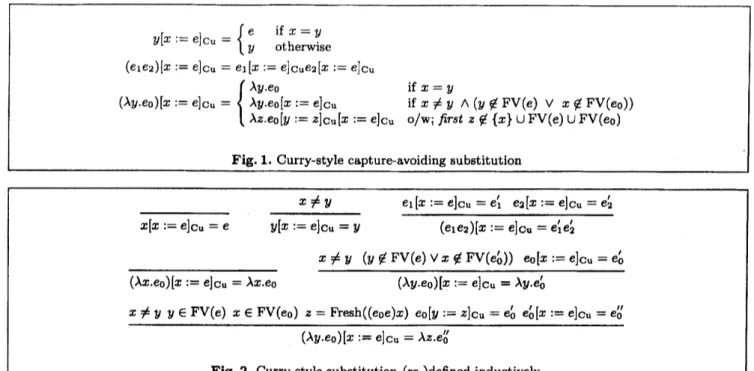
![Fig. 5. Renaming-free substitution, $-[-:= -]$ , defined recursively, and a-, 73-, $\eta-$ -reduction defined inductively over $\Lambda^{\mathrm{v}\mathrm{a}\mathrm{r}}$](https://thumb-ap.123doks.com/thumbv2/123deta/6024375.1065909/5.892.56.801.159.475/renaming-substitution-defined-recursively-reduction-defined-inductively-lambda.webp)
